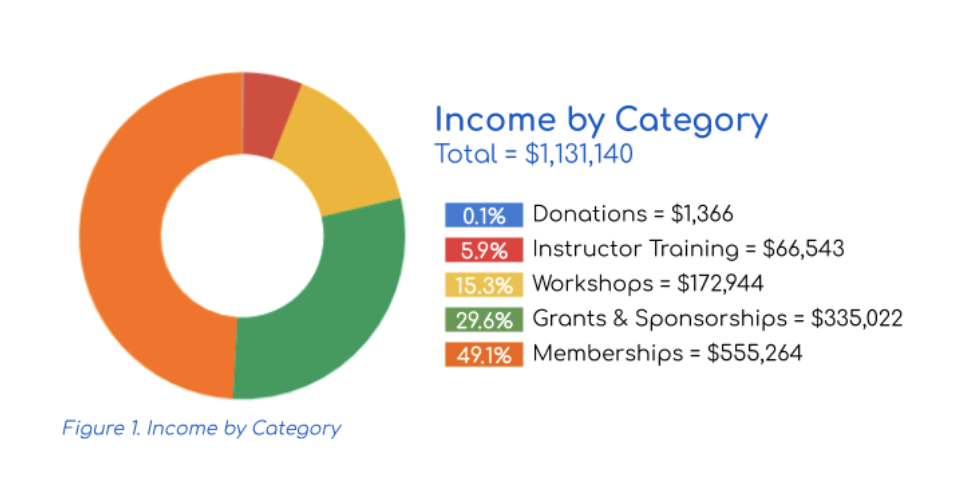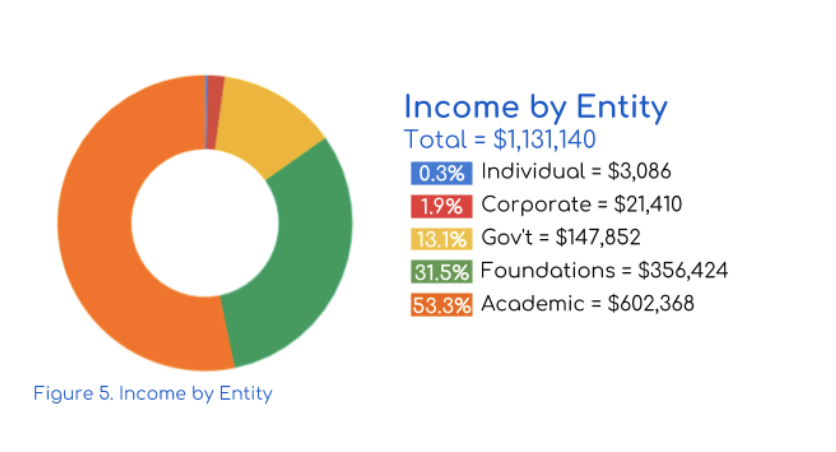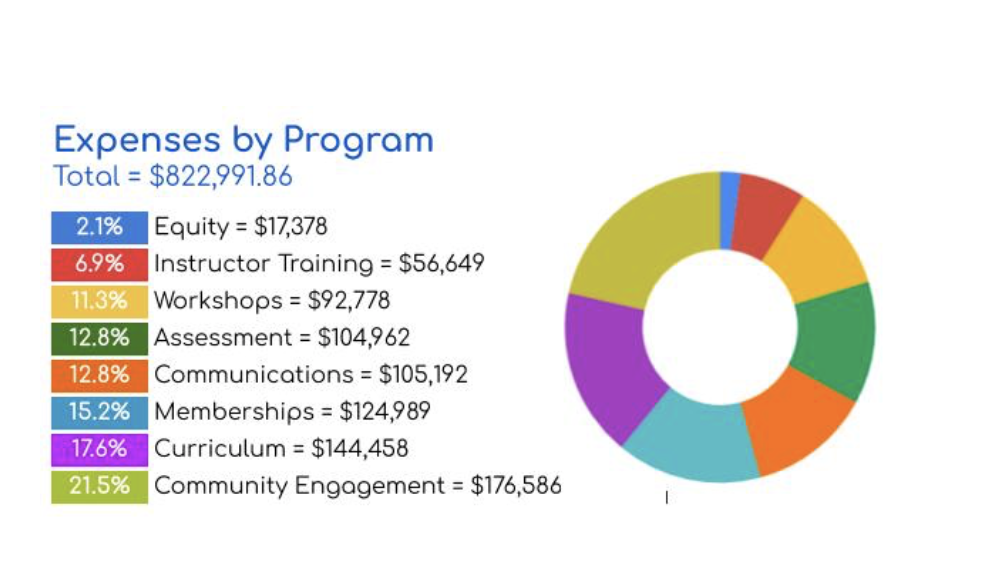Financial Updates
We have completed our first year as a joint project, The Carpentries, and now have more concrete information we can use to evaluate and plan for our long-term sustainability. Financial sustainability is a primary consideration in keeping our programs going, as financial resources allow us to pay for people and infrastructure, support our community and Member Organisations, teach workshops, connect with each other and develop local capacity for training, update resources, and develop new programs. You can see more details about our projects and personnel time in this blog post.
The Executive Council is responsible for financial oversight of The Carpentries. We have worked with the staff to evaluate programmatic revenue (revenue that’s generated from our programs - primarily workshops and Memberships), grant revenue and expenses, to better understand where we are and to plan for the future. Our programmatic revenue is doing a good job of supporting existing programs, but it’s not enough to support growth in new regions, develop new programs, or update necessary resources. In this blog post, we share our income sources, how we track our expenses, the resources we use for programs and thoughts about financial sustainability going forward.
Income
Our income is primarily from Organisational Memberships with Workshops and Grants being the other main contributors. Donations currently make up a very small component of our revenue, and Sponsorships were limited to support of CarpentryCon 2018. Primary grant funding is from the Alfred P. Sloan Foundation to support curriculum development infrastructure and domain specific lessons.

Mirroring where workshops are hosted, most of our revenue is from academic institutions, with government agencies also a significant component. Individual amounts are from donations, and Foundation revenue is from the Sloan curriculum grant award and grants or sponsorships for CarpentryCon 2018 from a few organisations. Corporate entity revenue comes from workshop fees for for-profit organisations, and 50% of revenue from these workshops goes to support workshops that reach new communities.

While this is our first year as The Carpentries, we’ve maintained an Organisational Membership program across Software Carpentry and Data Carpentry since 2015. Over that time period there has been a consistent increase in Memberships, and high renewal rates. One of the projects this quarter is evaluating that program to ensure it continues to meet the needs of new and existing Member Organisations.
We also see the need to diversify our revenue sources, particularly to support new programs and Carpentries community development in new regions. As a not-for-profit project, donations can be a key component of our revenue and this is something we need to explore. This quarter we are looking at a way for people who use and value learning from our lessons to contribute to our work by piloting a donation button on the Data Carpentry R Ecology lesson. Similarly Sponsorships, when evaluated to align with our mission and values, can be a source of support, and the Executive Council is working on a Task Force to consider a potential Sponsorship approach.
Expenses
Expenses for a not-for-profit are evaluated by programmatic expenditures, infrastructure and administration. In order to determine a break down of expenses for our different programs, all staff have job plans, where we allocate our time to particular programs. Also, all expenses and infrastructure costs are allocated to programs or administration. The majority of our expenditures go towards Programs. In 2018 we also had higher than usual Administrative expenses due to the transition both of merging The Carpentries and moving to a new fiscal sponsor. Fundraising expenses are time that was spent on writing grants and generating sponsorship for CarpentryCon.

Looking at expenses for each program, they were fairly evenly distributed. In 2018 we used Assessment and Equity as programs, In 2019, we have realised that these are incorporated into all of our work, so are exploring other more comprehensive ways of tracking those expenses. Most of our expenses are personnel, but we also develop and maintain custom and software-as-a-service infrastructure. We invest in the development and maintenance of our workshop database AMY and Etherpad infrastructure, and have standard web hosting, project management, email and community communications services.

Summary
Thanks to the work of The Carpentries Business team (Talisha Sutton-Kennedy and Elizabeth Williams) and the entire Carpentries staff and contractors who calculate their time on project work and have contributed to this information, we now have the first comprehensive overview of The Carpentries income and expenses to complement the 2018 Annual Report. This is crucial for the Executive Council in establishing a budget, and allowing us to determine strategic priorities that are consistent with budget resources. One thing that has become apparent in this overview is the need for more diversified revenue sources. We continue to support and improve our programmatic sources of revenue, but these sources alone aren’t enough to reach all of our goals for The Carpentries. As we continue through 2019, a primary goal of the Executive Council is to continue to carefully track income and expenses and work with The Carpentries staff and community, and our fiscal sponsor Community Initiatives, to diversify our revenue to support our mission and community. As we’ve grown as an organisation, we have a greater appreciation for the importance of the business side of operating a not-for-profit project, and that work invested here is crucial to achieving the objectives in our mission and reaching our potential.